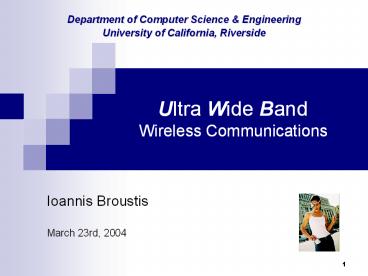Ultra Wide Band Wireless Communications PowerPoint PPT Presentation
1 / 21
Title: Ultra Wide Band Wireless Communications
1
Ultra Wide Band Wireless Communications
Department of Computer Science
Engineering University of California, Riverside
- Ioannis Broustis
- March 23rd, 2004
2
Motivation
- Current wireless solutions (IEEE 802.11,
Bluetooth) face some of the following problems - Limited channel capacity
- High power consumption
- Multipath fading
3
Why UWB?
- Advantages
- Low-power operation.
- Low cost.
- Low probability of detection and low probability
of jamming capabilities. - Low interference levels to existing services.
- Higher immunity to multi-path fading effects.
- Ability to penetrate walls, etc.
- Availability of precise location information.
4
What are we trying to do
- There are no sufficient solutions for the MAC
layer. - Limited previous work exists for UWB based ad hoc
networks. - We will address the problem of a suitable MAC
protocol for UWB ad hoc wireless networks.
5
Roadmap
- UWB definition and applications
- Possible PHY layer implementations
- MAC principles
- Previous Work on MAC layer
- Conclusions
6
UWB What is it?
- Any signal that
- Occupies at least 500MHz of BW, or
- More than 25 of a center frequency
- Wireless Personal Area Networks (WPANs)
- FCC allocates 7,500 MHz in the 3.1 to 10.6 GHz
band.
7
UWB Applications
- Stream DVD content to HDTVs simultaneously.
- Wirelessly synchronize appliance clocks.
- Connect high-data rate peripherals.
- Move huge files between digital cameras,
camcorders, and computers. - Military applications (radars, penetrate walls,
etc.)
8
What makes UWB so interesting?
- Manufacturers are still jumping on the UWB band
wagon even with the frequency and power
restrictions. - Why? Let an old friend explain
- Shannons theorem
9
PHY Single-Band and Multi-Band
- Single-Band Implementation
- One pulse occupies the whole BW.
- Multi-Band Implementation
- The 7.5GHz are divided into multiple bands.
- Information is independently encoded in the
different bands. - The lower limit of 500MHz must be maintained.
10
Single-Band and Multi-Band
11
Single-Band and Multi-Band
Multi-band signals transmitted at different
discrete times. The sequence repeats at each
symbol. Center frequencies are shown in the
vertical axis.
12
Why prefer Multi-Band ?
- Adaptive band selection ? Avoids interference.
- Low complexity ? Smaller transceiver cost.
- Low circuit frequency ? Power conservation.
Sacrifice one band for co-existence
13
IEEE 802.15.3a Requirements
14
MAC Principles
- Two main aspects
- Intra-WPAN interference
- Polling schemes (master/slave)
- CSMA
- CDMA
- TDMA
- A new idea...
- Inter-WPAN interference
- Time Hopping Spread Spectrum techniques.
15
UWB ad-hoc MAC - Previous Work
- 1 Jin Ding, Li Zhao, Sirisha Medidi and K. M.
Sivalingam, "MAC Protocols for Ultra-Wide-Band
Wireless Networks Impact of Channel Acquisition
Time", in SPIE ITCOM Conf. 4869, Boston, July
2002. - The channel acquisition time is large enough and
prohibits CSMA or TDMA approaches
TDMA
CSMA-CA
16
UWB ad-hoc MAC - Previous Work
- 2 H. Yomo, P. Popovski, C. Wijting, I. Z.
Kovacs, N. Deblauwe, A. F. Baena, and R. Prasad,
"Medium Access Techniques in Ultra-wideband Ad
Hoc Networks", the 6th national conference of
ETAI, 2003 September, 2003, Ohrid, Skopia. - They examine the Inter-WPAN interference approach
of the MAC layer. - The only way to control this kind of
interference is to determine appropriate values
for some Time-Hopping pattern parameters.
17
UWB ad-hoc MAC - Previous Work
- 3 Jean-Yves Le Boudec, Ruben Merz, Bozidar
Radunovic, Joerg Widmer, A MAC protocol for UWB
very low power mobile ad-hoc networks based on
dynamic channel coding with interference
mitigation, EPFL Technical Report ID IC/2004/02 - It is the 1st ad hoc MAC with Dynamic Channel
Coding. - Time-Hopping for Inter-WPAN interference.
- Schemes for
- Interference mitigation.
- Synchronization between transmitter and receiver.
- Dynamic channel coding with incremental
redundancy. - Private MAC Enforce that several senders
cannot communicate simultaneously with one
destination. ??
18
UWB ad-hoc MAC - Previous Work
- PRIVATE MAC
- Request ? Response ? Data? Ack.
- The request is sent to the receivers THS
(Time-Hopping sequence). - Response, Data and Ack are transmitted using a
common Sender-Receiver THS. - If no feedback is received, the sender will
re-transmit after a random backoff.
19
UWB ad-hoc MAC - Previous Work
- PRIVATE MAC (contd.)
- Assume that B is transmitting to A.
- An interfering node C will send a request to A
and will wait listening to As THS. - After the end of a successful transmission, A B
issue a beacon to their THS to inform other nodes
that they are idle. - If multiple nodes wait for A, they start counting
a backoff timer as soon as they hear the beacon. - With a proper synchronization scheme, collisions
are avoided.
20
Conclusions
- UWB is an excellent solution for high-speed WPANs
- Many times the maximum required data rate
- Power efficiency and no multi-path fading.
- The Multi-Band approach provides with even more
advantages. - A lot of work has been done in PHY.
- Upper layers must be examined in detail.
- Above MAC, nothing has been proposed.
21
Questions? (References available upon request)
General Atomics Multi-Band Transceiver Prototype

